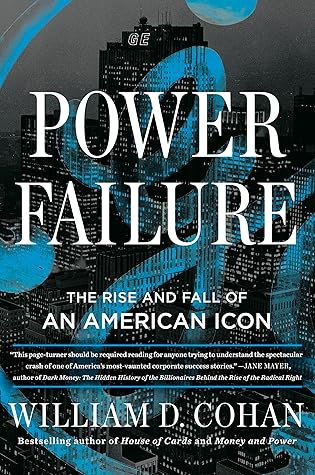More on this book
Kindle Notes & Highlights
Read between
December 30, 2022 - January 17, 2023
Bolze told me that he could sum up some of what he learned at GE as the “three Cs”—capital allocation, corporate governance, and culture.
He had thoughts to share on each. He said that starting with Jack, and increasingly under Jeff, too much capital was allocated to GE Capital and to M&A deals that didn’t pan out. GE Capital was a good business that got too big. He said Jeff “leaned into” real estate at GE Capital, and “that bit him in 2007.” He also said Jeff overpaid for acquisitions. “We would get into auctions,
or not, and we would pay big bucks,” he said. “Any banker would tell you that.” He said Jeff did some good deals, such as the acquisition of Enron’s wind business and Jenbacher’s distributed power business. But, he said, “the majority of GE’s acquisitions were overpaid for.” He said too much money was spent building out GGO and GE’s software business in Silicon Valley. “GE put some money in stock buybacks at probably the wrong levels,” he continued. “And the whole time along, you’ve got Blair Effron, one of the top guys from Centerview, advisi...
This highlight has been truncated due to consecutive passage length restrictions.
corporate gov...
This highlight has been truncated due to consecutive passage length restrictions.
GE’s culture
there wasn’t enough focus on profitable growth. “Growth without profitability is kind of irrelevant after ten years,”
As have others, he cited the problem he perceived as Jeff’s unwillingness to accept constructive criticism from other executives.
“Jeff Immelt is exhibit A for the failure of a Harvard MBA to perform well as a CEO,”
But the case method doesn’t seem to do a great job of teaching strategy.
My nominations are facts, focus, and integrity.
Jim Grant,
think where GE went wrong
was a loss of moral compass,” he said. “The loss, the conceit, of a company that believes it can do no wrong, because after all, it is GE.”
“You wouldn’t fund that, because after all, you could always roll it, because after all, you’re GE,” he said. He marveled at GE’s growing “dependence” on a financial services business “that was susceptible to all the cyclicality of credit businesses since the dawn of lending and borrowing,” noting that somehow “the cyclicality of that kind of business was not front of mind in the GE C-suite.”
hubris.
In a subsequent conversation with me—years later—Jeff was far more lucid about what had happened at GE during his tenure. But he was still reluctant to blame himself.
He surprised me by conceding that Jack made a mistake by walking away from the Honeywell deal. He thought GE should have closed that deal.
Honeywell would have achieved for GE many of things Jeff tried to do with the Alstom acquisition—only to fail—including bulking up GE’s industrial businesses and diluting the importance of GE Capital.
GE’s market value fell by half during Jeff’s tenure, including by 25 percent in 2017 alone. Still, his “realized compensation” for 2017, according to GE’s 2018 proxy statement, was $30 million.
The present value of these benefits totaled some $113 million at the time of his departure. He also left with more than $75 million of GE stock, much of which he had bought with his own money.
He pointed out that Jeff
had spent $80 billion on deals.
Nearly alone among all the hundreds of people I spoke with about GE, Jack thought Jeff made a mistake by getting rid of GE Capital.
He criticized Jeff’s decision to use the proceeds of the sale of GE Capital to buy back GE stock. “He was buying back stock and not taking care of the debt,” he said. “He got all those dividends from GE Capital. He was exiting it and he bought back the stock.”
Jack said Jeff didn’t understand balance sheets or operations. “That’s a bad combination,” he continued. “He understood marketing. He was advertising like crazy.”
said the most important res...
This highlight has been truncated due to consecutive passage length restrictions.
of a CEO was delivering consistency...
This highlight has been truncated due to consecutive passage length restrictions.
That is the heart of this bullshit about managing earnings, staying up all night fooling with the balance sheet. We didn’t do that. He didn’t understand it, so he took risks that were out of proportion. He didn’t follow up on earnings. He didn’t pay attention. He had meetings on operations and was disinterested.
Jack blamed the GE board for allowing Jeff to allocate capital toward buying back stock instead of paying down debt.
“Corporate governance is a big part of this story. Where was it?
back to candor, back to straight talk, back to rigor.
On the industrial side of its business, of course, GE housed a staggering amount of talent. It’s not crazy to think of GE, and its DNA, back in the day as the technological equivalent of Apple, Google, or Microsoft today. By one estimate, GE has more than 35,000 active patents and has received hundreds of thousands of patents since 1892. The innovations continue to this day. In 2018, GE unveiled a new family of engines that can be used to power a coming generation of supersonic jets.


